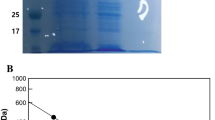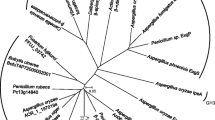Abstract
Enzymatic deramnosylation of flavonoids is a convenient tool for improving the quality of citrus juices. α-L-rhamnosidase with a specific activity of 33.1 units/mg was isolated and characterized from the culture liquid of Penicillium tardum. The molecular weight of the enzyme was 95 kDa according to the data of gel filtration on Sepharose 6B and gel electrophoresis in SDS-PAGE. The pH optimum of the enzyme activity was 5.0, and the thermo optimum was 60 °C. Enzyme showed high stability in the temperature range of 45–50 and at 60–70 °C. It retained 80 to 50% of the initial activity for 90 min. The half-life of α-L-rhamnosidase at 70 °C increased twofold in the presence of 20–40% glycerol and 2.3-fold in the presence of 4 M sorbitol. The enzyme was completely inhibited in the presence of 10−3 M Ag+ and Cd2+ and approximately by 90% in the presence of Fe2+, Fe3+, and Al3+ ions. More than 60%, the enzyme activity was inhibited by Hg2+, Co2+, and 1-(3-dimethylaminopropyl)-3-ethylcarbodiimide methiodide. Activating effect of Ca2+ ions was also noted. Km and Vmax for the hydrolysis of p-nitrophenyl-α-L-rhamnopyranoside and naringin were 0.7 mM and 38.3 µM/min/mg and 1.34 mM and 43.7 µM/min/mg, respectively. Penicillium tardum α-L-rhamnosidase hydrolyzed naringin, neohesperidin, hesperidin, rutin, and narirutin at high rate, which allowed us to consider it as an effective tool for transformation of bioflavonoids in food industry.






Similar content being viewed by others
References
Quideau, S., Deffieu, D., Douat-Casassus, C., & Pouysegu, L. (2011). Plant polyphenols: Chemical properties, biological activities, and synthesis. Angewandte Chemie. International Edition, 50, 586–621.
Yadav, V., & Yadav, K. D. S. (2010). New fungal for α-L-rhamnosidase an important enzyme used in the synthesis of drugs and drug precursors. Applied Biochemistry and Microbiology, 48, 295–301.
Valentova, K., Vrba, J., Bancirova, M., Ulrichova, J., & Kren, V. (2014). Isoquercitrin: Pharmacology, toxicology, and metabolism. Food and Chemical Toxicology, 68, 267–282.
Xiao, J. (2017). Dietary flavonoid aglycones and their glycosides: Which show better biological significance? Critical Reviews in Food Science and Nutrition, 57, 1874–1905.
Slamova, K., Kapesova, J., & Valentova, K. (2018). “Sweet flavonoids”: Glycosidase-catalyzed modifications. International Journal of Molecular Sciences, 19, 2126.
Kumar, D., Yadav, S., Yadav, S., & Yadav, K. D. S. (2019). An alkali tolerant alpha-L-rhamnosidase from Fusarium moniliforme MTCC-2088 used in de-rhamnosylation of natural glycosides. Bioorganic Chemistry, 84, 24–31.
Zhang, R., Zhang, B. L., Xie, T., Li, G. C., Tuo, Y., & Xiang, Y. T. (2015). Biotransformation of rutin to isoquercitrin using recombinant α-L-rhamnosidase from Bifidobacterium breve. Biotechnology Letters, 37, 1257–1264.
Ge, L., Chen, A., Pei, J., Zhao, L., Fang, X., Ding, G., Wang, Z., Xiao, W., & Tang, F. (2017). Enhancing the thermostability of α-L-rhamnosidase from Aspergillus terreus and the enzymatic conversion of rutin to isoquercitrin by adding sorbitol. BMC Biotechnology, 17, 21.
Yadav, M., Sehrawat, N., Sharma, A. K., Kumar, V., & Kumar, A. (2018). Naringinase: Microbial sources, production, and applications in food processing industry. Journal of Microbiology, Biotechnology and Food Sciences, 8, 717–720.
Guillotin, L., Kim, H., Traore, Y., Moreau, P., Lafite, P., Coquoin, V., Nuccio, S., De Vaumas, R., & Daniellou, R. (2019). Biochemical characterization of the alpha-L-rhamnosidase DtRha from Dictyoglomus thermophilum application to the selective derhamnosylation of natural flavonoids. ACS Omega, 4, 1916–1922.
Alvarenga, A. E., Amoroso, M. J., Illanes, A., & Castro, G. R. (2014). Cross-linked α-L-rhamnosidase aggregates with potential application in food industry. European Food Research and Technology, 238, 797–801.
Li, L., Gong, J., Wang, S., Li, G., Gao, T., Jiang, Z., Cheng, Y. S., Ni, H., & Li, Q. (2019). Heterologous expression and characterization of a new clade of Aspergillus alpha-L-rhamnosidase suitable for citrus juice processing. Journal of Agriculture and Food Chemistry, 67, 2926–2935.
Terada, Y., Kometanti, T., Nishimurah, K., Taki, I., & Okada, S. (1995). Prevention of hesperidin crystal formation in canned mandarin orange syrup and clarified orange juice by hesperidin glycosides. Food Sci. Technol. Int. T., 1, 29–33.
Gonzalez-Barrio, R., Trindade, L. M., Manzanares, P., de Graaff, L. H., Tomas-Barberan, F. A., & Espin, J. C. (2004). Production of bioavailable flavonoid glucosides in fruit juices and green tea by use of fungal alpha-L-rhamnosidases. Journal of Agriculture and Food Chemistry, 52, 6136–6142.
Yanai, T., & Sato, M. (2000). Purification and characterization of an alpha-L-rhamnosidase from Pichia angusta X349. Bioscience, Biotechnology, and Biochemistry, 64, 2179–2185.
Scaroni, E., Cuevas, C., Carrillo, L., & Ellenrieder, G. (2002). Hydrolytic properties of crude alpha-L-rhamnosidases produced by several wild strains of mesophilic fungi. Letters in Applied Microbiology, 34, 461–465.
Baudrexl, M., Schwarz, W. H., Zverlov, V. V., & Liebl, W. (2019). Biochemical characterisation of four rhamnosidases from thermophilic bacteria of the genera Thermotoga. Caldicellulosiruptor and Thermoclostridium. Sci. Rep., 9, 15924.
Wu, T., Pei, J., Ge, L., Wang, Z., Ding, G., Xiao, W., & Zhao, L. (2018). Characterization of a alpha-L-rhamnosidase from Bacteroides thetaiotaomicron with high catalytic efficiency of epimedin C. Bioorganic Chemistry, 81, 461–467.
Zhang, T., Yuan, W., Li, M., Miao, M., & Mu, W. (2018). Purification and characterization of an intracellular alpha-L-rhamnosidase from a newly isolated strain, Alternaria alternata SK37.001. Food Chemistry, 269, 63–69.
Singh, P., Sahota, P. P., & Singh, R. K. (2015). Evaluation and characterization of new α-L-rhamnosidase-producing yeast strains. Journal of General and Applied Microbiology, 61, 149–156.
Yadav, V., Yadav, S., Yadav, S., & Yadav, K. D. (2012). Alpha-L-rhamnosidase from Aspergillus clavato-nanicus MTCC-9611 active at alkaline pH. Prikladnaia Biokhimiia i Mikrobiologiia, 48, 328–333.
Yadav, S., Yadava, S., & Yadav, K. D. (2017). α-L-rhamnosidase selective for rutin to isoquercitrin transformation from Penicillium griseoroseum MTCC-9224. Bioorganic Chemistry, 70, 222–228.
Ishikawa, M., Shiono, Y., & Koseki, T. (2017). Biochemical characterization of Aspergillus oryzae recombinant α-L-rhamnosidase expressed in Pichia pastoris. Journal of Bioscience and Bioengineering, 124, 630–634.
Pachl, P., Skerlova, J., Simcikova, D., Kotik, M., Krenkova, A., Mader, P., Brynda, J., Kapesova, J., Kren, V., Otwinowski, Z., & Rezacova, P. (2018). Crystal structure of native alpha-L-rhamnosidase from Aspergillus terreus. Acta Crystallographica Section D, 74, 1078–1084.
Li, L., Yu, Y., Zhang, X., Jiang, Z., Zhu, Y., Xiao, A., Ni, H., & Chen, F. (2016). Expression and biochemical characterization of recombinant alpha-L-rhamnosidase r-Rha1 from Aspergillus niger JMU-TS528. International Journal of Biological Macromolecules, 85, 391–399.
Liu, T., Yu, H., Zhang, C., Lu, M., Piao, Y., Ohba, M., Tang, M., Yuan, X., Wei, S., Wang, K., Ma, A., Feng, X., Qin, S., Mukai, C., Tsuji, A., & Jin, F. (2012). Aspergillus niger DLFCC-90 rhamnoside hydrolase, a new type of flavonoid glycoside hydrolase. Applied and Environment Microbiology, 78, 4752–4754.
Gudsenko, O. V., & Varbanets, L. D. (2015). Optimization of cultivation conditions of Penicillium tardum - the α-L-rhamnosidase producer. Mikrobiolohichnyi Zhurnal, 77, 25–31.
Chaplin, M. E., & Kennedy, J. E. (Eds.). (1986). Carbohydrate analysis: A practical approach. Oxford IRL Press.
Koseki, T., Mese, Y., Nishibori, N., Masaki, K., Fujii, T., Handa, T., Yamane, Y., Shiono, Y., Murayama, T., & Iefuji, H. (2008). Characterization of an alpha-L-rhamnosidase from Aspergillus kawachii and its gene. Applied Microbiology and Biotechnology, 80, 1007–1013.
Murakami, S., & Kinoshita, M. (2016). Effects of monohydric alcohols and polyols on the thermal stability of a protein. The Journal of Chemical Physics, 44, 125105.
Awad, G., Abd El Aty, A. A., Shehata, A. N., Hassan, M. E., & Elnashar, M. M. (2016). Covalent immobilization of microbial naringinase using novel thermally stable biopolymer for hydrolysis of naringin. 3 Biotech, 6, 14.
Sandoval-Cardenas, D. I., Reyes-Guzman, E. G., Gracida, J., Rodriguez Morales, J. A., Ramos-Lopez, M. Á., & Amaro-Reyes, A. (2021). Production of combined-cross-linked hemicellulosic enzyme aggregates from paperboard residues. Biologia, 76, 3919–3924.
Avila, M., Jaquet, M., Moine, D., Requena, T., Pelaez, C., Arigoni, F., & Jankovic, I. (2009). Physiological and biochemical characterization of the two alpha-L-rhamnosidases of Lactobacillus plantarum NCC245. Microbiology, 155, 2739–2749.
Rojas, N. L., Voget, C. E., Hours, R. A., & Cavalitto, S. F. (2011). Purification and characterization of a novel alkaline alpha-Lrhamnosidase produced by Acrostalagmus luteo albus. Journal of Industrial Microbiology and Biotechnology, 38, 1515–1522.
Hashimoto, W., Miyake, O., Nankai, H., & Murata, K. (2003). Molecular identification of an alpha-L-rhamnosidase from Bacillus sp strain GL1 as an enzyme involved in complete metabolism of gellan. Archives of Biochemistry and Biophysics, 415, 235–244.
Zverlov, V. V., Hertel, C., Bronnenmeier, K., Hroch, A., Kellermann, J., & Schwarz, W. H. (2000). The thermostable alpha-L-rhamnosidase RamA of Clostridium stercorarium: Biochemical characterization and primary structure of a bacterial alpha-L-rhamnoside hydrolase, a new type of inverting glycoside hydrolase. Molecular Microbiology, 35, 173–179.
Terry, B., Ha, J., Lise, F. D., Mensitieri, F., Izzo, V., & Sazinsky, M. H. (2020). The crystal structure and insight into the substrate specificity of the α-L rhamnosidase RHA-P from Novosphingobium sp. PP1Y. Archives of Biochemistry and Biophysics, 679, 108189.
Ni, H., Xiao, A. F., Cai, H. N., Chen, F., You, Q., & Lu, Y. Z. (2012). Purification and characterization of Aspergillus niger α-L-rhamnosidase for the biotransformation of naringin to prunin. African Journal of Microbiology Research, 6, 5276–5284.
Funding
The work was funded by the National Academy of Science of Ukraine (No. 0113U001217).
Author information
Authors and Affiliations
Contributions
All authors contributed to the study conception and design. Material preparation, data collection, and analysis were performed by Nataliya Borzova, Olena Gudzenko, and Lyudmila Varbanets. The first draft of the manuscript was written by Nataliya Borzova, and all authors commented on previous versions of the manuscript. All authors read and approved the final manuscript.
Corresponding author
Ethics declarations
Ethics Approval
Not applicable.
Consent to Participate
Not applicable.
Consent for Publication
Not applicable.
Competing Interests
The authors declare no competing interests.
Additional information
Publisher's Note
Springer Nature remains neutral with regard to jurisdictional claims in published maps and institutional affiliations.
Supplementary Information
Below is the link to the electronic supplementary material.
Rights and permissions
About this article
Cite this article
Borzova, N., Gudzenko, O. & Varbanets, L. α-L-rhamnosidase from Penicillium tardum and Its Application for Biotransformation of Citrus Rhamnosides. Appl Biochem Biotechnol 194, 4915–4929 (2022). https://doi.org/10.1007/s12010-022-04008-1
Accepted:
Published:
Issue Date:
DOI: https://doi.org/10.1007/s12010-022-04008-1




